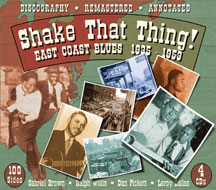Product Details
- An MVD Exclusive
- SKU: JSP7753
- Format: CD
- UPC: 788065775322
- Street Date: 06/27/06
- PreBook Date: 01/01/01
- Label: JSP Records »
- Genre: Country
- Run Time: mins
- Number of Discs: 4
- Year of Production: 2006
- Box Lot: 6
- Territory: NORTH AMERICA
Product Assets
Shake That Thing: East Coast Blues 1935-1953
A Mythical Source of Late Country Blues

- List Price: $28.99
- Your Price: $28.99
- In Stock: 3
You must login to place orders.
The eastern seaboard of America, from Florida to New York, is over1300 miles long and encompasses numberless individual styles. Post WW2, as the artists here demonstrate, a strong current of aggressively fingerpicked blues persisted. In May, 1949, Billboard declared, 'Joe Davis re-signed blues warbler-guitarist Gabriel Brown prior to return to cutting race platters.' The session didn't take place until the start of August at RCA when four titles were cut. RCA turned down the acetates but in September Decca bought two and released the single on their Coral subsidiary. Brown disappears until late 1952, when Billboard reported that Joe Davis had 'recently signed a flock of r&b talent to personal contracts, and has placed a number of them with diskeries'. Gabriel Brown was mentioned. After an intermittent career, one final Gabriel Brown release was pitched to negligible effect. Nothing is known of him thereafter. Even less is known of Dan Pickett. Three decades after his 1949 session(s) it was discovered this wasn't even his name. He was James Founty. In all, seventeen songs were recorded, even though his contract called for only eight. Two years elapsed before he cut a further solo session for Savoy as Alabama Slim, opening with an adaptation of one of Judson Coleman's tunes, this time as Going To Virginia. His well-recorded guitar was lively and strong. For someone who recorded as much as Ralph Willis, he's something of a blank. It's said he was born in 1910, somewhere in Alabama, that early in the 1930s he moved to the Winston-Salem area in North Carolina, where it is said he met up with the likes of Buddy Moss, Blind Boy Fuller, Sonny Terry and Brownie McGhee. Before the end of the 1930s he'd moved to New York City. He made his recording debut, as Ralph ('Bama) Willis, in 1944. Sometime later, another Savoy session featured the combative presence of Pete Sanders's washboard. This time he was Washboard Pete and then Sleepy Joe & His Washboard Band.
